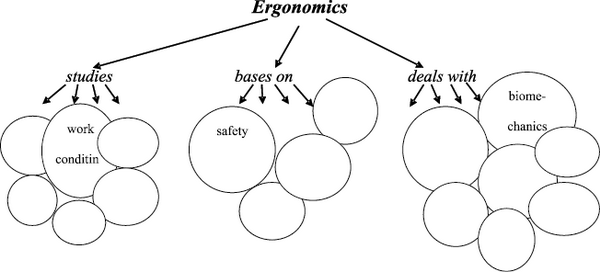
Научная электронная библиотека
Монографии, изданные в издательстве Российской Академии Естествознания
Unit 4. What is ergonomics?

The computer seems harmless enough but not for the people who sit in front of computers all day long. They wonder: Are computer users getting bad radiation? What about eyestrain, the age-old back problem, the risk of miscarriage etc.?
A lot is done today for limiting radiation from computers. Manufacturers, for instance, offer screens with build-in protection now. But meanwhile, there are a number of things workers can do to take care of themselves. A good place to begin with32 is an ergonomically designed workstation.
Ergonomics is the study of how people interact safely and efficiently with machines and their work conditions. In general, ergonomics is a science concerned with33 the ‘fit’ between people and their work. It takes account of the worker’s capabilities and limitations in seeking to ensure that tasks, equipment, information and the environment suit each worker.
The term “ergonomics” is derived from34 two Greek words: “ergon”, meaning work, and “nomoi”, meaning natural laws.
To assess the fit between a person and their work, ergonomists consider the job being done and the demands on the worker; the equipment used (its size, shape, and how appropriate it is for the task), and the information used (how it is presented, accessed, and changed). Ergonomics draws on35 many disciplines in its study of humans and their environments, including anthropometry36, biomechanics, mechanical engineering, industrial engineering, industrial design, kinesiology37, physiology and psychology.
There are five aspects of ergonomics: safety, comfort, ease of use, productivity/performance, and aesthetics.
A properly designed workstation takes a variety of factors into account38, such as the distance from the eyes to the screen and the angle of the arms and wrists. There is a list of some guidelines for making your workstation more ergonomic:
● Turn the screen away from the window to reduce glare.
● Put your monitor on a tilt-and-swivel base39.
● Get a good chair, one that supports your lower back and is adjustable40, so you can change its height and angle.
● Position the keyboard at the same height as your elbows, with your arms parallel to the work surface.
● Do not bend your wrist when you type.
● You should place your mouse within easy reach41. It supports your forearm.
● Position the monitor42 at, or just below eye level. You should look at the monitor, not up.
● You should sit at the arms length from the front of the monitor, about 50 to 70 centimeters away.
● Sit with your feet firmly on the floor or on the footrest43
● You shouldn’t use a monitor that’s fuzzy44 or distorts the image.
● Keep the screen clean to prevent distorting shadows45.
● Use LCD screens instead of CRT monitors. They are free from radiation.
● Exercise at your desk occasionally rotating your wrist, rolling tour shoulders and stretching. Don’t stare at the screen46 for long periods of time, look away from the monitor. Better yet47, get up and walk around at regular intervals.
● Don’t open the monitor. It is dangerous. And if you decide to build your own PC, protect yourself from electric shocks. You shouldn’t touch any components unnecessarily.
Notes to the text:
32. a good place to begin with – лучше всего начать с того, что…;
33. be concerned with – ассоциироваться с чем-либо;
34. is derived from – происходит от;
35. to draw on – опираться на;
36. anthropometry – антропология (метод антропологического исследования, который заключается в измерении тела человека и его частей с целью установления особенностей его физического строения, позволяющий дать количественную характеристику его изменчивости);
37. kinesiology – кинезиология (наука, изучающая движение во всех его проявлениях; имеющая практическое применение, в первую очередь, в медицине);
38. to take a variety of factors into account – учитывать многие факторы;
39. on a tilt-and-swivel base – на шарнирной (вращающейся) основе;
40. adjustable – регулируемый;
41. within easy reach – в пределах лёгкой досягаемости;
42. position the monitor –расположите монитор; (Слово position имеет сходство с существительным по словообразовательным признакам, но часто употребляется не только как существительное, но и глагол, как в данном контексте).
43. to sit with your feet firmly on the floor or on the footrest- устойчиво расположить свои ноги на полу или на подставке для ног;
44. fuzzy – нечёткий, расплывчатый;
45. to prevent distorting shadows – предотвратить искажение теней;
46. to stare at the screen – пристально смотреть на экран;
47. Better yet – а ещё лучше…
Tasks for the text:
1. Put the necessary word into the sentence:
1) You should … at the monitor, not up.
2) LCD screens are free from …
3) It is dangerous to … the monitor.
4) There are a number of things … can do to take care of themselves.
5) Sit at the … length from the front of the monitor.
6) Don’t … any components unnecessarily.
7) Producers offer … with build-in protection now.
8) An ergonomic workstation takes … of factors into account.
2. Complete the sentences using words from the text or words with the appropriate meaning:
1) A lot is done for …
2) Ergonomics is a science concerned with …
3) Five aspects of ergonomics are …
4) If you have an adjustable chair, you can change …
5) Ergonomists consider the job being done and the demands on the worker, the equipment used and …
6) Protect yourself from electric shocks if you decide …
7) Ergonomics draws on many disciplines including…
8) For making your workstation more ergonomic there is …
3. Match the questions with their replies:
|
Number |
Question |
Reply |
|
1 |
What kind of people worry about health problems caused by computer? |
It’s a footrest. |
|
2 |
What have manufacturers done for limiting radiation from computers? |
Those who sit in front of computers all day long are afraid of this. |
|
3 |
What screen is the least dangerous? |
Do it at regular intervals. |
|
4 |
How far should you sit from the front of the monitor? |
Do it within easy reach. |
|
5 |
Where should you place your mouse? |
Position it at the same height as your elbows. |
|
6 |
What is the name of the item that helps you keep feet firmly on the floor? |
They’ve offered screens with build-in protection. |
|
7 |
When is it necessary to have a rest when working on computer? |
LCD. It is free from radiation. |
|
8 |
How should you place the keyboard? |
The distance should be about 50 to 70 centimeters away from it. |
4. Complete the diagram in the form of cluster:

5. This is a picture of a workstation. Draw a picture of your own workstation at the office or at home. Point out where your things are placed and explain why you have put them there.

Use names of the following things and helpful phrases from the box (if you want):
CPU –
Keyboard –
Monitor –
Mouse –
Printer –
Fax machine –
Discs –
Papers –
Speakers –
Reading lamp –
|
on the right (left); to the right (left) of the window; in the corner; on the desk; in the drawing; on the shelf; above the table; in front of the monitor; near the monitor; under the table… |
Example: My papers are placed in the copyholder. This way they are in the easy reach.
6. Analyze the features of the monitors concerning their influence upon people’s health. Complete the table:
|
Number |
object of influence |
CRT (Cathode ray tube) monitor |
LCD (Liquid crystal display) monitor |
|
1 |
radiation |
high |
low |
|
2 |
image |
….. |
….. |
|
3 |
adjustment |
…… |
…… |
|
4 |
voltage |
7. Imagine that you are an ergonomist. Write a list of guidelines for giving advice how to use the lighting (overhead lights, desk lamps) by work on computer. Use the imperative or should/shouldn’t to give instructions.
